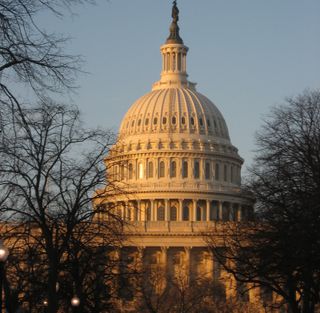NTIA Reauthorization Legislation Morphs Into Broadband Bill

The National Telecommunications & Information Administration got a tire-kicking Tuesday (June 26) in a hearing in the House Communications Subcommittee on what was billed as rural broadband legislation, including coordinating funding efforts and getting more accurate and granular maps of broadband coverage, as one legislator put it.
It has been 25 years since the NTIA was reauthorized, which was apparent from the draft reauthorization bill being considered at the hearing. The bill opened with instructions to strike the "$17,600,000 for fiscal year 1992 and $17,900,000 for fiscal year 1993" and replace it with $50,800,000 for each of years 2019 through 2021.
Rep. Marsha Blackburn (R-Tenn.), chairman of the subcommittee, had signaled to reporters not long after she took over the subcommittee from now House Energy & Commerce Committee Chairman Greg Walden (R-Ore.), that reauthorizing NTIA was one of her priorities.
She pointed out at the hearing that an NTIA reauthorization hearing was her first hearing as chair back in February 2017 and that since then the subcommittee has held nine NTIA-related hearings, including an oversight hearing earlier this year.
Agencies get funded under separate appropriation bills and continue operating under existing authorizations, but renewing them provides Congress a chance to tweak an agency's mission, give it some new direction--or directions--and perhaps some more tools. The bill's direction was clearly toward ubiquitous broadband.
In fact, Blackburn called the bill a "rural broadband bill," and "a very important one at that." Dems suggested it was
She said that there is bipartisan consensus for the bill, as well as for NTIA to come up with a comprehensive and accurate broadband availability map.
Rep. Mike Doyle (D-Pa.), ranking member of the subcommittee, put in a plug for the AIRWAVES Act, which he said suggested should get some more love from the subcommittee.
He said the authorization bill was a good start, but more money was needed for broadband "shortfalls," including via a $40 billion LIFT AMERICA Act sponsored by Rep. Frank Pallone (D-N.J.), ranking member of the parent Energy & Commerce Committee.
Related: LIFT America Act Could Fund Overbuilds
Multichannel Newsletter
The smarter way to stay on top of the multichannel video marketplace. Sign up below.
Pallone said that he was not impressed with the bill, saying it was limited on substance and fell short of giving NTIA the resources it needed.
"I am disappointed that my Republican colleagues have circulated a discussion draft that does little more than reintroduce Congressman Tonko’s ACCESS BROADBAND Act," he said, "which the subcommittee recently marked up and has already reported to the full committee."
He also noted that current NTIA administrator David Redl was not in attendance at the hearing and said the bill should not proceed until they had input from the current Administration.
On the broadband front, the bill establishes an Office of Internet Connectivity and Growth within NTIA to do outreach to communities in need of high-speed broadband as well as hold workshops and develop training tools to help expand adoption and access.
And in a move that warms the hearts of ISPs often complaining about overbuilding and potential waste, fraud and abuse in government subsidies, the new office would create a database identifying how federal broadband money was being used, including tracking construction and access to any infrastructure build-out.
Getting a handle on just where broadband is and isn't is obviously key to efficient deployment.
The office will be required to provide annual reports to the Congress on what the office has done, including how many residents got broaband as a result of federal spending and the economic impact of those deployment efforts.
It would also coordinate with and streamline applications for broadband support funds from various sources,
including the FCC-overseen Universal Service Fund (USF), the Agriculture Department's Rural Utilities Service, and several others.
Michael Gallagher, president of the Entertainment Software Association but testifying as the former administrator of NTIA, talked about the need for boosting broadband deployment, including with better availability maps, and protecting the WHOIS regime that helps combat IP theft. He called NTIA a "low-cost, high-impact" agency.
He said that particularly important to NTIA's mission are "improving rural broadband access, including by expanding the availability of spectrum for commercial use, and (2) ensuring the continued viability of WHOIS," which he called a "transparency tool" that is "vital to law enforcement, consumer protection, and intellectual property rights in the Internet ecosystem."
Also testifying was former NTIA administrator John Kneuer, who put in a plug for making sure the government was not subsidizing broadband where it was already provided by commercial operators. "Scarce resources should be deployed where there are actual gaps in coverage, rather than in competition with private capital," he said.
The bill also includes "sense of the Congress" provisions about the need for combating cybersecurity threats and protect the supply chain, both hot-button issues with the rash of breaches, data sharing security threats from Chinese telecoms.
The sense of the Congress is that NTIA should "coordinate a forward-looking Federal response to cybersecurity threats to, and supply chain vulnerabilities in, communications networks." Another such statement says NTIA should make sure that new laws and regulations (the EU's new GDPR privacy framework notable among them) should not undermine the WHOIS system for identifying who is purchasing and managing domain names.
Redl told the Senate Commerce Committee last week that the WHOIS system could be at risk from pressure to conform to GDPR rules.
The FCC was also reauthorized this year for the first time since 1990 via the RAY BAUMS Act.
Contributing editor John Eggerton has been an editor and/or writer on media regulation, legislation and policy for over four decades, including covering the FCC, FTC, Congress, the major media trade associations, and the federal courts. In addition to Multichannel News and Broadcasting + Cable, his work has appeared in Radio World, TV Technology, TV Fax, This Week in Consumer Electronics, Variety and the Encyclopedia Britannica.

